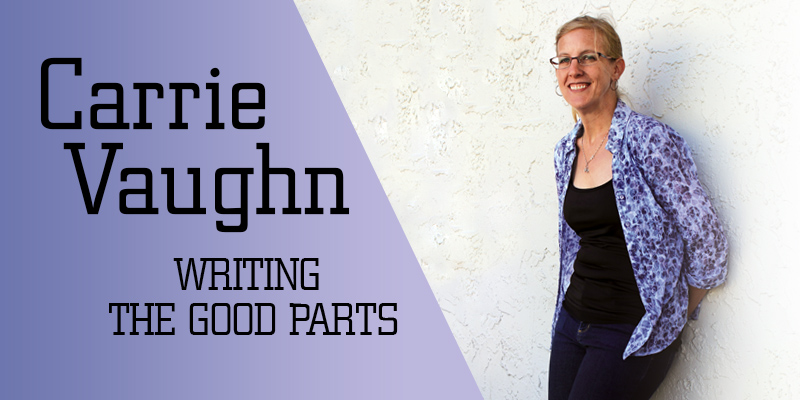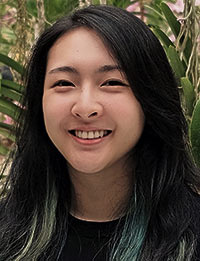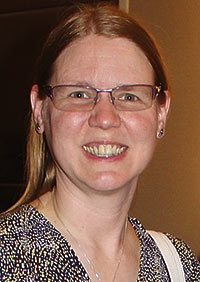Carrie Vaughn: Writing the Good Parts

Carrie Vaughn was born January 28, 1973 in Sacramento CA to a military family, and grew up all over the country before settling in Colorado, where she graduated high school. She attended Occidental College in Los Angeles, and got her Master’s in English Literature at the University of Colorado in Boulder. She attended the Odyssey Writing Workshop in 1998, and taught there in 2009. Vaughn began publishing short fiction in 1999. “Doctor Kitty Solves All Your Love Problems” (2001) launched the Kitty Norville series about a werewolf radio talk show host, which includes debut novel Kitty and The Midnight Hour (2005). The series has 15 volumes so far, most recently Kitty Saves the World (2015). Vaughn remains a prolific short fiction writer, and often writes stories set in the worlds of her novels. “Amaryllis” (2010) was a Hugo Award finalist, as was “That Game We Played During the War” (2016). Some of her short work is collected in Straying From the Path (2011) and Amaryllis and Other Stories (2016). She’s also written work in the Wild Cards shared universe. Other novels include the After the Golden Age superhero series: After The Golden Age (2011) and Dreams of the Golden Age (2014). Her standalone books include Voices of Dragons (2010), Discord’s Apple (2010), Steel (2011), and Martians Abroad (2017). She moved into postapocalyptic SF with Bannerless (2017), first in a series, with sequel The Wild Dead forthcoming. Vaughn lives in Colorado.
Excerpts from the interview:
“I’ve been writing a series of stories set in the same post-apocalyptic world as Bannerless. The foundational concept of the series is that this is a community that rose up after a catastrophic series of apocalyptic events that wiped out civilization. They conscientiously built up a society that is based on sustainability. It’s based on quotas, and managing resources so no one exploits them. They want to make sure that everybody is taken care of, and that they have the resources to take care of people into the future, so it’s a bit of an environmental foundation. They’re trying to look at what happened before, and exploiting resources was something that contributed to the fall of civilization, so they very strictly manage their resources. As a result, they’re very concerned with how many children are born, and they want to make sure that every child born has a place and will be taken care of. They have strict birth control, and it’s mandatory until you and your household have proven you can take care of a child. Society is mostly arranged in households, so it’s not individuals who are granted the right to have children, but an entire household. It’s expected that people will live in clusters of communities. Somebody living by themselves is suspect. It’s not illegal, but it’s just understood that you can’t raise a child by yourself in this world. The people who built up the society started at a medical clinic that eventually became known as Haven, and everything has expanded out from there. There’s an aspect of protection to it – people are part of this society because it’s safe. They look out for each other, and there’s a lot of concern for helping each other. Even with all the restrictions, it’s a good place to be. People agree to the rules in exchange for that safety. ‘
‘The first Coast Road story, ‘Amaryllis’, was in the premiere issue of Lightspeed, in 2010, and was a Hugo finalist. When you have a setting like that, the stories spring out. There were more issues I want to explore, so I wrote, ‘Astrophilia’, and then ‘Bannerless’, the short story version of the novel. The potential was always there to set a novel in that world, but it wasn’t until I wrote ‘Bannerless’, with the character of Enid, the investigator, that the way to write novels in that world presented itself. I used the form of the murder mystery, a classic formula, but not one I had a lot of experience with. I was up for the challenge. Making it a mystery was a way to write a post-apocalyptic novel that wasn’t strictly a post-apocalyptic novel. The post-apocalyptic novel has been done a lot, particularly in recent years. Some people call this world a dystopia, but I don’t necessarily think it’s dystopian. The classic form of dystopia tends to be authoritative, authoritarian, and rigid, in the mold of 1984 or Brave New World, and that’s not what I’m doing.
“Writing the short story really opened up the possibilities for how to tell more stories in the world. Each of the stories focuses on an idea, but a novel has to be more than an idea, and the murder mystery gave me a structure. At that point, the sky’s the limit. When you have an investigator character like that, you can just follow them as long as you’re willing to keep writing them. The second book will be out next year. It’s called The Wild Dead. We’ll see what comes after that. I was really glad when Enid came along. A lot of writers talk about characters taking over the story, and that doesn’t always happen with me, but it happened with Enid. It also happened with Kitty, from my Kitty Norville books. Those are the two characters that jumped off the page and said, ‘Hey, you can write a lot of stories about me if you want.’ It’s a really cool thing when it happens. Then you have to start making decisions about overarching storylines and continuity.
“Writing a series is interesting because you can go one of two ways. You can make the stories all standalone, so they reset at the end of each book, and are more episodic – mysteries tend to do that. The character herself doesn’t necessarily change from one book to another. There may be life moments that happen to keep the character realistic. Or you can have an overarching storyline that ties all the individual stories together – epic fantasy tends to do that, where it’s multiple volumes telling a single story rather than episodes. Or you can land somewhere in the middle – Lois McMaster Bujold’s Vorkosigan series is like that. You can read them entirely out of order, but there’s a character arc that extends over all the novels.
“It’s hard when you’ve got the potential for a long series, and you don’t necessarily get to make those decisions in a logical, formal way. Sometimes you’ve got to go by the seat of your pants and see what works. It’s hard for me to remember why the short story version of ‘Bannerless’ was about Enid at the end of her career, except that’s a trope – the last great case before she retires. In the book I definitely wanted to go to the start of her career because there’s a lot of potential there. I wanted to play with how she became the kind of person she is, and the kind of investigator she is, and explore her relationship with her community and her society in general. It’s a pretty formal society that was built with a lot of thoughtfulness, but the structures have been in place long enough now that nobody is left who remembers what the world was like before things collapsed. That’s a really big deal. There’s no longer a direct connection to the world before. Enid in particular feels that. She had a direct connection with Auntie Kath, who remembered the old days, but Kath is gone now, so how can Enid maintain that connection? How can she know what the society is trying to do? It’s the Founding Father question: what did they mean to do? How are things changing? Are they changing for the better for the worse? It’s almost metafictional, the worldbuilding questions that go into it. These characters are building their own world, while I’m trying to tell the story of that world.
“Another short story set in the world is due out on Tor.com, called ‘Where Would You Be Now.’ It’s a prequel. It takes place about five years after everything has fallen apart, when people realize things are not going back to the way they used to be. Auntie Kath is the main character of the story, set when she’s about 20 years old. The Wild Dead is another murder mystery. Enid visits a household on the very edges of their society, so there’s a lot of interaction with the nomadic peoples who live outside the society, and a bit of conflict there. Enid has a new partner she doesn’t quite know what to do with – he’s younger than her, and she’s suddenly become the mentor figure, and she doesn’t know if she’s up for that. Once again, her own evolution is running in parallel with the world, learning to relate to people who aren’t part of her society. I get so many ideas that don’t necessarily fit in to one story. I wonder what’s going on in other countries. Do people have radios, and how do you find somebody else who has a radio to communicate with? The lack of technology in Bannerless and the Coast Road series as a whole seems a little extreme, but at the same time I look around and see how fragile things are. If we lose GPS, we lose a lot. If we lose the electrical grid, we lose a lot. Once we lose that, we lose things like water treatment. I’ve been thinking about fires. The typical thing in a postapocalyptic movie is you walk into the abandoned city and there are buildings, the infrastructure is still there, but what happens when you have a fire, but no firefighters or fire control systems? How much of what we think would be standing would simply be wiped out by fires that rage out of control? There was a major earthquake in San Francisco a hundred years ago, but it was the fires that did much of the damage.






